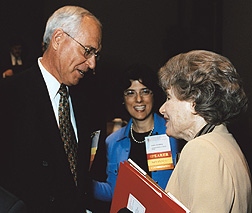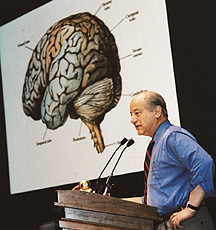| T
H E N I H C A T A L
Y S T |
M
A Y – J U
N E 2001 |
|
'HOW
THE SOCIAL WORLD GETS
UNDER OUR SKIN':
THE
SCIENCE OF MIND-BODY
INTERACTIONS
|
by Esther
Sternberg, Director
Integrative Neural Immune Program
|
 |
|
Collegial
Interactions
(left to right): Robert
Rose, conference co-chair and director of the MacArthur Foundation Mind-Body
Network; Esther Sternberg, conference co-chair and director of the NIMH
Intramural Integrative Neural Immune Program (and author of this article);
and acting NIH director Ruth Kirschstein.
In
his introductory remarks, Rose emphasized the importance of skeptical
enthusiasm and solid scientific research to further the field of mind-body
science. Much of the data presented during the meeting grew out of interdisciplinary
projects jointly funded by NIH and the MacArthur Foundation Mind-Body
Network.
In
her conference-opening remarks, Kirschstein emphasized the increasing
importance of interdisciplinary research, pointing to several NIH interdisciplinary
initiatives in mind-body science research, including the university-based
Mind-Body Centers funded through OBSSR and the newly established intramural
Integrative Neural Immune Program at NIH.
|
The
Science of Mind-Body Interactions conference, held at Masur Auditorium March
26–28, 2001, was hosted by the NIH Intramural
Integrative Neural Immune Program (see box) and cosponsored by the John
D. and Catherine T. MacArthur Foundation, NIMH,
NINDS, and 13 other NIH institutes, centers,
and offices: NCI, NHLBI,
NIA, NIAID,
NIAMS, NIDA,
NIDCR, NLM,
NCCAM, ORWH,
OBSSR, OIR,
and the National Center on Sleep Disorders
Research, NHLBI. Hailed as a "demonstration of a paradigm shift in
medicine," * the conference was attended
by 500–and viewed simultaneously by 1,200 people in the United States and
Canada, thanks to the web group at CIT.
Concepts embedded in the
popular culture for thousands of years were recast in the bright light of
science earlier this year at a three-day conference here—the first of its
kind at NIH to address the effects of such variables as individual social interactions
and psychological responses on the molecular and cellular mechanisms of disease
processes.
Emphasizing intervening
brain pathways, molecules, and hormones, the conference on the "Science
of Mind-Body Interactions" provided scientific mechanisms from the fields
of neurobiology, immunology, and endocrinology to explain how the "social
world gets under our skin"—a theme of the conference coined by Harvard
science historian and MacArthur Foundation Mind-Body Network member, Anne Harrington.
 |
|
Gerald
Fischbach, former NINDS director and currently vice president for health
and medical sciences and dean of medicine, Columbia University, New York,
returned to NIH to present his views on integrative research. During his
tenure here, Fischbach was instrumental in supporting both the MacArthur/NIH
Science of Mind Body Interactions conference and the Integrative Neural
Immune Program.
|
Research directly connecting
health effects observed at an epidemiological level to individual psychological
and physiological health variables is not abundant. But conference speakers
systematically highlighted cutting-edge research on the neurobiology of emotions;
neural and neuroendocrine factors affecting autoimmune, inflammatory, allergic,
and infectious diseases; and the very long arm of sleep or the lack of it.
Nancy Adler (University
of California at San Francisco), director of the MacArthur Foundation Research
Network on Socioeconomic Status (SES) and Health, presented evidence that lower
SES is associated in a dose-related manner with adverse health outcomes. Among
those SES factors that compromise health are poor living conditions, exposures
to toxins and environmental irritants, stress, depression, and lack of medical
care and follow-up. Most importantly, Adler said, perceived inequality leading
to alienation and isolation could be factors in initiating a chain of negative
health effects.
Loneliness
The notion that social
isolation predicts higher morbidity
and mortality, especially in elderly, poor, and minority populations, was dramatically
supported in three separate studies of the cardiovascular status of lonely individuals.
Reported by John Cacioppo
(University of Chicago) and Julian
Thayer (NIA, Baltimore), all three
studies linked loneliness to greater sympathetic nervous system reactivity,
higher blood pressure, or greater perceived stress. Components of this "threat"
pattern (high impedance, low cardiac output), as opposed to "challenge"
pattern (high cardiac output, low peripheral resistance) of cardiac reactivity,
were seen in populations as varied as 2,600 undergraduate students, elderly
individuals in Chicago, and elderly, isolated African Americans in inner-city
Baltimore.
Preliminary findings from
another study by Cacioppo and David Spiegel (Stanford [Calif.] University) provided
additional support that feeling lonely can change psychological response patterns:
When subjects who were not lonely were hypnotized into a lonely state, they
experienced a shift in psychological variables from a challenge pattern to the
threat pattern observed in truly lonely people.
Martha McClintock (University
of Chicago) presented animal data showing that group-housed rats lived 40 percent
longer than isolated animals. The cause of death in the isolated animals was
related to opportunistic infections and tumors, suggesting that state of the
organism rather than type of pathogen was a key factor.
Electricity
That emotional responses
can be viewed as a transduction process by which social variables might affect
health was further explored in a session on the neurobiology of emotions, chaired
by Richard Davidson (University of Wisconsin at Madison). Davidson presented
data combining the tools of PET and fMRI neuroimaging and EEG brain electrical
activity mapping to show that differences in emotional circuitry are
linked to differences in brain approach-and-withdrawal systems and differences
in emotional style.
There is no single emotional
center in the brain. Rather, many centers work together to detect conflict and
recruit response centers that then generate behaviors leading to mood alteration
and ultimately to goal achievement.
Large-scale longitudinal
studies carried out over several decades in Wisconsin show that individual differences
in patterns of brain electrical activity, blood flow, and metabolism are associated
with different emotional response patterns and differences in host resiliency.
Michael Meaney (McGill
University, Montreal, Quebec) presented evidence that factors in early development,
including maternal-offspring interactions, can influence hormonal and neuronal
pathways at a molecular and cellular level and result in permanent alterations
of the set-point of the hormonal stress response.
John Sheridan (Ohio State
University in Columbus) reported that mice subjected to the stress of social
reorganization experienced higher mortality from viral infection and reactivation
of herpesvirus. These outcomes were related to impaired immune responses and
cell trafficking and changes in immune molecules that orchestrate these responses.
Perchance
To Dream
The final session focused
on an often- ignored fact of life that may account for many of the deleterious
effects of emotions and stress on health: lack of sleep. This session, chaired
by Eve Van Cauter (University of Chicago), surveyed the diverse consequences
of sleep deprivation—from increased risk of motor vehicle accidents as
a result of impaired cognition and motor skills and increased irritability to
an array of hormonal changes (including increased blood cortisol, decreased
growth hormone, and induced insulin resistance) that can impair immune function,
retard growth, accelerate aging, and compromise sugar metabolism to the level
of diabetes.
Interactive panel discussions
throughout the conference, which engaged the audience in lively debate, also
served as forums for related issues, including findings with implications for
new therapeutic approaches. Among these were the use of an antidepressant phosphodiesterase
inhibitor for immune suppression in the autoimmune disease multiple sclerosis
and the therapeutic potential for pain management that can be deduced from the
discovery of chemokine-opiate receptor interactions. 
The archived videocast
of the conference is accessible online.
*
Uttered by
Emeran Mayer, director of the UCLA Mind Body CRC and CURE Neuroenteric Disease
Program, who seemed to speak for many.
|
Integrative Neural Immune Program
The
NIH Integrative Neural Immune Program is designed to foster intramural
interdisciplinary research in the field of neural-immune interactions,
the biological basis of the so-called "mind-body" interaction.
The program’s
structure also accommodates interagency, university, and private sector
partnerships.
The program encompasses
the study of molecular, cellular, and neuroanatomical mechanisms of neural-immune
interactions, as well as systems-level analysis of communications between
the central nervous, endocrine, and immune systems.
This research has
relevance to the role of the immune system in neuronal cell death and
repair, neuronal development and plasticity, and the role of the nervous
and neuroendocrine systems in susceptibility and resistance to autoimmune,
inflammatory, allergic, and infectious diseases.
Basic research in
this area has clinical implications for understanding the pathogenesis
of and developing treatments for diseases such as multiple sclerosis,
Alzheimer’s, AIDS, stroke, nerve trauma, and brain tumors.
It will inform our
understanding of the effects of depression, stress, and beliefs on immune-mediated
conditions, such as arthritis and allergic and infectious diseases.
This intramural
research program will bridge neurobiology and immunology laboratories
and related clinical branches through a series of cores—Administrative
Core, Virtual Core, Scientific Communications Core, Laboratory Core, and
Training Core.
A series of on-campus
neural-immune lectures and intramural-extramural workshops and conferences
is taking shape to foster interactions among participating labs, define
the current state of the field, and create new research agendas. (The
first major gathering was the "Science of Mind-Body
Interactions" conference.)
Resources to facilitate
interdisciplinary collaborative research, as well as a neural-immune training
program, should well serve the program’s ultimate goal: to enable
researchers to rapidly address cutting-edge multidisciplinary research
questions and to translate basic research findings into tangible clinical
health outcomes. More than 85 scientists currently participate in the
program.
Directed by Esther
Sternberg, chief of the NIMH Neuroendocrine Immunology and Behavior
Section, the program is based at NIMH and is co-sponsored by NINDS, NCI,
NIA, NIAID, and NIAMS and the OIR. 
|
Return to Table of Contents

